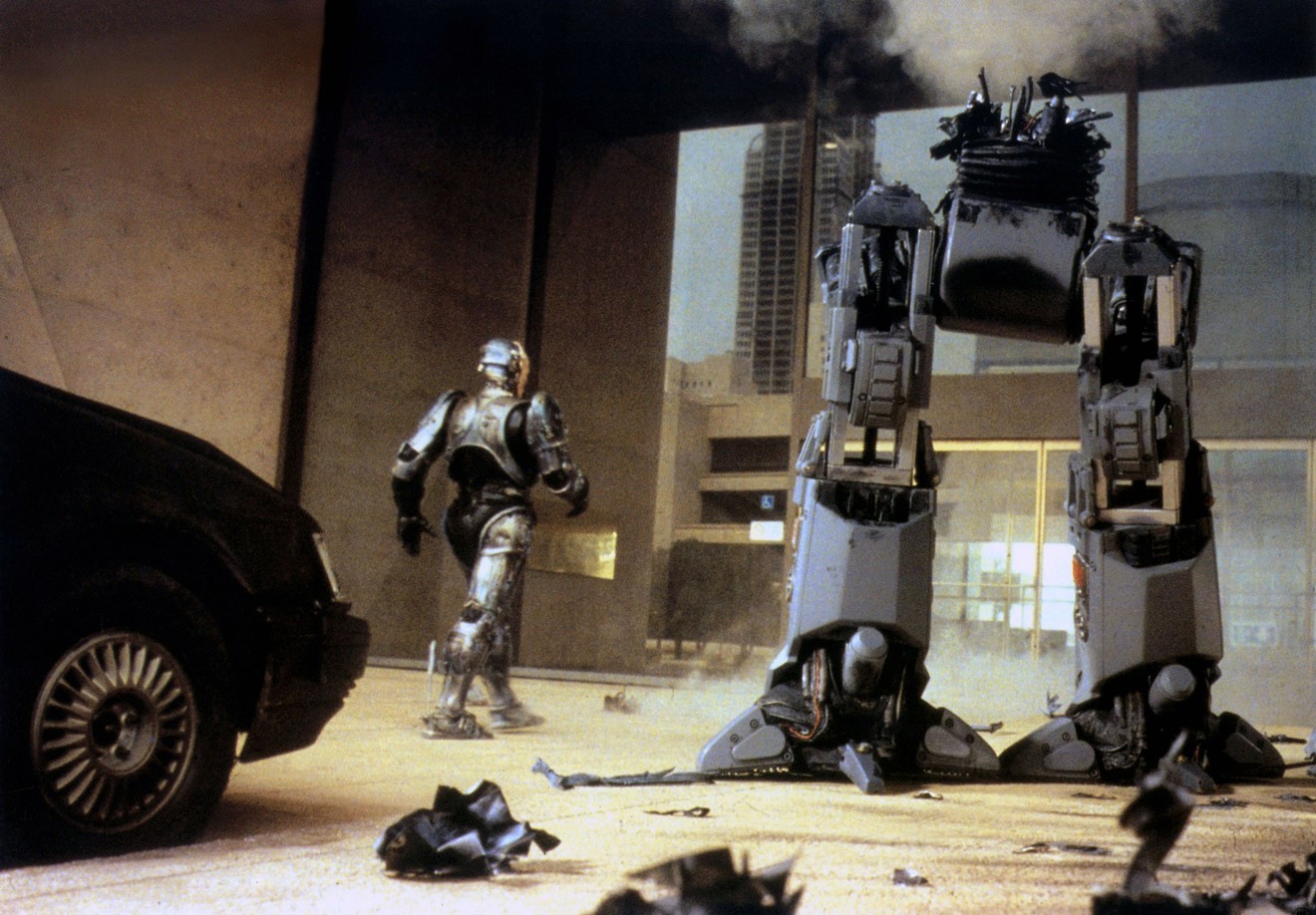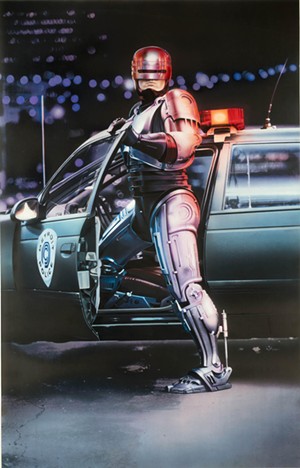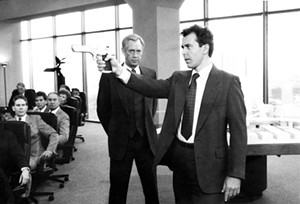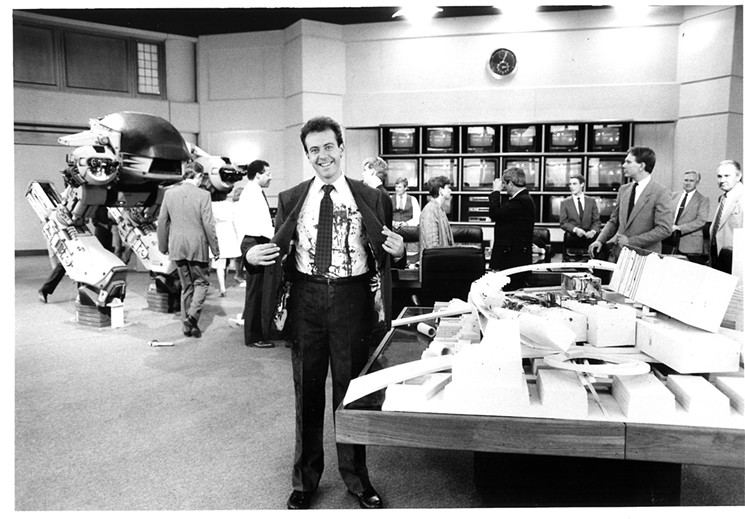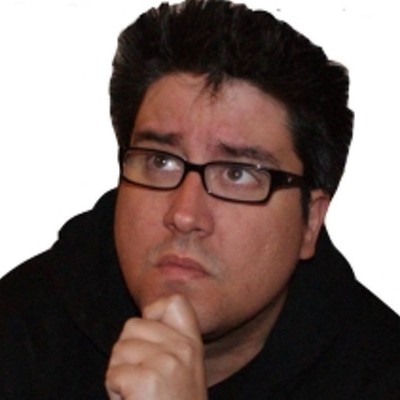Durrett's boss asked him to wear it in front of the theater to attract more customer traffic. So he roasted inside the suit in the Texas summer heat “because I happened to be the same size as the actor or the stuntman who wore it,” he says.
RoboCop takes place in a futuristic Detroit, dubbed "Old Detroit," where crime runs rampant and the police department is a private entity run by a private military and security company where executives conspire with the criminals they are hired to fight. Durrett had no idea this massive sleeper hit, which went on to become the 16th highest-grossing film of the year and a staple of the satiric sci-fi genre, was made in his hometown of Dallas until one of its more memorable and destructive scenes came up.
The military and security firm, OCP, constructs RoboCop — played by University of North Texas alum Peter Weller — from the human remains of a fallen Detroit police officer. A crime kingpin named Clarence Boddicker (Kurtwood Smith) and his gang had murdered the officer, Alex J. Murphy.
RoboCop starts to recall his human identity and track down members of Boddicker’s gang after stopping a robbery at a gas station that gang member Emil Antonowsky (Paul McCrane) blows up by igniting a puddle of gasoline with his cigarette.
Durrett says he recognized Dallas when the gas station went up in flames.
“That gas station was down the street from a barbecue joint my dad loved to go to and was just a vacant gas station forever,” Durrett says. “The moment I saw that in the movie, I was like, "Whoa, that’s that
The public didn’t seem to know the Orion Pictures production, Verhoeven's first blockbuster, was in town filming in the summer of 1986. Only the people involved in the production and some city officials who gave the go-ahead for Verhoeven and his crew to film all over the Dallas area were in the know.
"Films and commercials were being shot out there and a lot of people were coming to Dallas to shoot. For a while, Dallas was called the Third Coast." – actress Angie Bolling
tweet this
More than most Texas cities, Dallas attracted productions for TV movies of the week; commercials; a few Oscar-winning classics, like director Arthur Penn’s Bonnie and Clyde; and the primetime CBS soap opera Dallas.
"At that time, studios in Las Colinas were new, and a lot of productions were going on out there," says Dallas actress Angie Bolling, who played Murphy's wife in a series of flashback scenes in RoboCop. "Films and commercials were being shot out there and a lot of people were coming to Dallas to shoot. For a while, Dallas was called the Third Coast."
Since then, the competition to attract more productions with tax incentives has become fierce among states like Texas,
RoboCop, however, was a different metallic beast for Dallas.
“I think we all were aware it was a pretty cool film because of all the different stuff they had been doing,” says Dallas film
Dallas was more than just the economic epicenter for all of the film’s explosions, gunfire and endless downpours of fake blood that Verhoeven wanted for his movie. Dallas' role in RoboCop was physically bigger even than Weller’s crime-fighting robot.
“The whole movie was shot in Dallas, except for the steel factory scene at the end,” Verhoeven says from his home in Holland. “Ultimately, we felt that Dallas would give us that, shall we say, Old Detroit.”
"You are going to be a bad mother fucker."
The movie’s script came from the collaborative minds of screenwriters Edward Neumeier and Michael Miner. Both came up with similar ideas for a futuristic action flick featuring a superhuman police officer in a live-action comic book film. The two teamed up to write RoboCop in 1984 and started shopping it around the studios. The idea was met with a series of rejections until movie producer Jon Davison saw something worth exploring in their treatment and passed it on to a senior vice president at Orion Pictures.Neumeier and Miner’s movie featured a mix of styles that pitted machines against ruthless gangsters in an urban wasteland and wove the narrative with a Frankenstein story in which the central character struggles to understand his identity. The movie also explored the sinister corporate influence on national defense and public service, demonstrating how profit and pursuit of the public good always seem to be at odds.
“I was moonlighting on the set of Blade Runner in the Burbank studios that’s now Warner Bros.,” Neumeier says, referring to the 1982 sci-fi film directed by Ridley Scott. “I would go over at night and just join the crew because it was so big that nobody knew. In that location on that set, I had that vision of this policeman and for RoboCop. I think
Neumeier says the corporate themes of the movie came before he and Miner started throwing gun-toting robots into the mayhem. Miner says the timing couldn’t have been better for audiences who were being introduced to new technologies like automation and home computers. The headlines were also filled with national issues regarding corporate greed and President Ronald Reagan’s missile defense system, which was nicknamed the “Star Wars” program.
Neumeier and Miner also contrasted the movie’s high-octane action with comedy. Tongue-in-cheek parodies of popular sitcoms, TV news programs, and commercials for nuclear warfare-themed board games and a gas-guzzling sports car all made the film.
“We tried as much as possible to get that stuff in there,” Miner says, “because it was comic relief for a cynical decade.”"That skyline with the wide, flat topography thrusting up and the Dallas City Hall became something they extended with a matte painting. And at 3 a.m. you could shoot off some blanks there and blow up an old part of town." – screenwriter Michael Miner
tweet this
Davison,
“I came from a really different background making movies in Holland,” Verhoeven says. “They were more realistic. They were much more about real people. I think doing science-fiction, although I admire Star Wars which was already there at that time, I felt it really was not my film very much, and I started to realize it when I was reading the script. It was sci-fi and fantasy, and I was not into it, but my wife pointed out there were aspects of the story that would attract me and be of interest to me.
"There’s the story of RoboCop visiting his house, where he’s already RoboCop and he finds out he was called Murphy before, and he finds out where he lived, and there’s these kinds of feelings and flashbacks about his wife and his son. In fact, when I started to read it more precisely, that was really the scene that convinced me from a theological point-of-view that there were elements there that I felt were interesting."
Orion Pictures gave Verhoeven just under $12 million to make the movie, which meant he had to scale back on his original vision for the picture. Verhoeven says he had wanted to build a more futuristic set like Blade Runner's, but Davison gave him an ultimatum.
“The excellent producer Jon Davison said, 'We can make the backgrounds fantastic in the direction of Blade Runner, but we can’t have the costume, so what do you want, the costume or the background?'” Verhoeven says.
Verhoeven chose to focus his budget on making RoboCop’s armor look high tech, but he found a way to get the futuristic scenery he wanted by shooting in Dallas. The mix of postmodern skyscrapers and historic buildings could be fashioned to look like a crumbling Detroit. Locations like Sons of Hermann Hall in Deep Ellum and the Mercury Studios building in Los Colinas were optimal for interior scenes at OCP’s headquarters and the Detroit police station where RoboCop is beta-tested.
“It was supposed to be the day after tomorrow and more futuristic looking than sci-fi,” Miner says. “That skyline with the wide, flat topography thrusting up and the Dallas City Hall became something they extended with a matte painting. And at 3 a.m., you could shoot off some blanks there and blow up an old part of town. It was very friendly for what we needed to do.”
"There’s a new guy in town. His name is RoboCop."
Verhoeven and his crew worked with a short timeline and small budget, the latter of which they eventually exceeded. However, it was no problem to find actors and crew members in Dallas to fill out the various roles and responsibilities, whom they would otherwise have had to fly out from LA and housed in Dallas.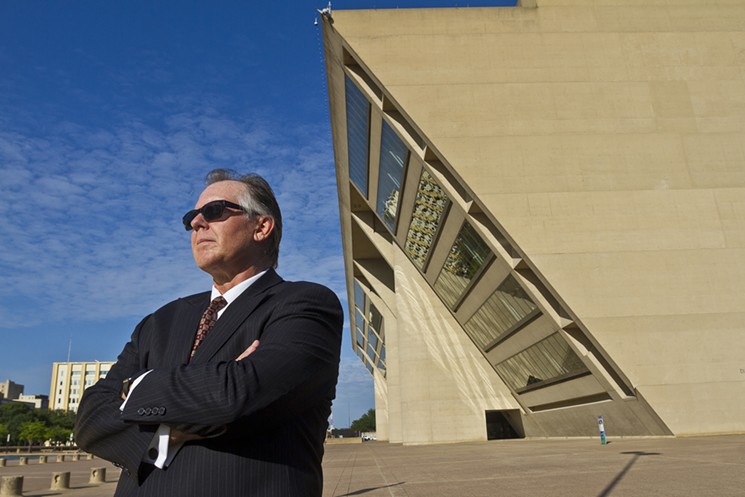
Kevin Page stands in front of Dallas City Hall, which was altered with CGI to become part of a dystopian future Detroit in RoboCop.
Mark Graham
Kinney’s violent death happens in full view of the OCP board and its president, giving Jones' rival, junior executive Bob Morton (the late Miguel Ferrer), a window of opportunity to push his RoboCop program into production.
The role was Page's first big-screen speaking role. He landed it just before his second year of graduate school in theater at Southern Methodist University.
“They put a bunch of squibs on me and basically blew me up with firecrackers and fake blood,” Page says. “Verhoeven didn’t think that was bloody enough. He was really trying to make a statement with the movie about movie violence, so he really wanted to take it over the top.”
Page’s initial filming lasted only three days in a makeshift studio in downtown's Renaissance Tower made to look like OCP’s corporate boardroom, but Verhoeven called him back to the set in Las Colinas, outfitted with an identical boardroom, so they could make his death gorier.
“We were all wearing rain ponchos because when the blood would go off, it would start raining down on us,” says Burklund, production assistant.
Page recalls the crew’s resourceful methods for meeting Verhoeven’s gore quotient.
“The story goes that Verhoeven kept sounding, ‘More blood! More blood!'" Page says. “So at lunchtime on the third day, the technician who did the special effects was in the lunch hall, and they were serving spaghetti squash. They took a handful of the spaghetti squash and stuffed it in a baggie and put a bunch of fake blood in there and blew it up.”
The film’s unforgiving violence earned RoboCop an X rating and an infamous reputation before its initial release. Verhoeven and his editors had to recut the film several times to get it to a friendlier R rating.
“I think that whatever you want to call the
The film also featured impressive explosions that took place on the streets of Dallas. The scene in which crime kingpin Boddicker tests a new piece of military hardware on a block of stores was shot in Deep Ellum on Elm Street. That explosion gave some of the actors who played Boddicker’s gang quite a shock, and viewers can see it when they watch the film.
“When he shoots the window, there was such a big explosion that you can see it in the reaction of the actor, and he dives away,” Verhoeven says with a laugh. “We were all shocked. That was beyond what anybody had in mind. Everybody just looked at each other and said, ‘Wow, we survived.’”
The gas station explosion at the intersection of Ross Avenue and Arts Plaza also surprised people on set and drivers on the nearby highway.
Don Tapani, who worked as a RoboCop stand-in for Weller, says he was a block away from the gas station explosion. No one expected it to be as big as what was captured on film.
“A lot of people driving on the freeway when it happened thought a real gas station exploded and called the fire department,” Tapani says. “They had to delay the shooting because the Dallas Fire Department showed up thinking it was a real fire. It looked so realistic, too. That was the great thing about it.”
Russell Towery, a stuntman who worked on several big-budget movies and often did stunts for Weller, had to walk through the massive wall of fire dressed as RoboCop. When Verhoeven yelled cut, “the whole suit was smoking,” Towery says.

Russell Towery (left) works with actor Peter Weller as a stuntman for the original RoboCop.
Courtesy of Russell Towery
Towery had another scary scrape with one of the film's explosions. During the hallway scene in which RoboCop fights the ED-209 drone for the first time, an explosive planted in a wall detonated near his arm and blew him across the hallway. He suffered a contusion and had to go to the hospital, but he went right back to the set.
“I wasn’t gonna let anyone take my job,” Towery says.
The violent nature of the movie wasn’t its dominating feature. Weller’s performance, Verhoeven's vision, and Neumeier and Miner’s script gave a sense of humanity and humor to an otherwise violent lead character in a chaotic movie.
“I just noticed with all the dark violence, what struck me was the humor,” says Bolling, the Dallas actress. “I had no idea that dark humor was going to be so prevalent. That’s what made it so enjoyable to me. It was a really intense, very intense experience, and I think it still holds up. I’ve seen it so much over the years on the small screen, but when they had the 25th anniversary, I saw it on the big screen at the Texas Theatre, and it still holds up.”
“I’d buy that for a dollar!”
The film became one of the most memorable hits of 1987. According to BoxOfficeMojo.com, RoboCop made just over $8 million in its opening weekend and went on to make more than $53 million in sales by the following November. RoboCop also picked up Academy Award nominations for best editing and best sound.
The movie not only attracted adult audiences, thanks to its smart story and its
“I think as a kid, you’re drawn to the surface-level stuff like he’s a robot cop and Peter Weller’s presence,” says James Wallace, creative director for the Alamo Drafthouse DFW chain. “He wasn’t like the other leading men of that time in those type of movies. He wasn’t Arnold Schwarzenegger. I think as a kid, you’re drawn to all that stuff and the violence and the big gun, but it’s funny, these movies we’ve watched so many times as a kid, that you have a relationship with them and you connect to different things with them.”
The success of the movie gave many of its stars and crew credibility in Hollywood. Verhoeven’s work on RoboCop scored him the director’s chair for the Arnold Schwarzenegger action film Total Recall and the erotic thriller Basic Instinct, the latter of which generated widespread controversy and acclaim.
Weller’s role as RoboCop led to more memorable roles in movies such as Screamers, Naked Lunch and, more recently, Star Trek Into Darkness.
Cox says his performance in RoboCop helped him break out of the nice-guy typecasting that had constrained his career. Now when he meets fans, he says, they expect him to be the douchebag he is on screen in RoboCop. Cox went on to play other villains, including in Total Recall.
“For me personally, that was made great by Paul Verhoeven,” Cox says of RoboCop. “It was a chance for me to stretch and get to go to some place that I hadn't gotten to go to before and play the bad guy. That was the main appeal for me.”
Don Broughton of Dallas, a sound boom operator who worked on RoboCop and many other mainstream films, says much of the credit for the film’s success goes to the local crew. It also made Dallas one of the most attractive prospects for filming and served as an example to other cities of how to run a film crew.
“We were such a well-put-together crew and so cohesive that we were like a well-oiled machine,” Broughton says. “A lot of producers who visited and saw what we were doing said, ‘Let’s do it in Texas,’ and ‘Let’s do it in Dallas.’ We all went to different places to make movies separately from the Texas crew. We all taught a lot of people to do what we did.”
Neumeier, one of the film's screenwriters, also credits the city for RoboCop's continued relevance and ability to attract new eyes 30 years later.
“It’s interesting how well Dallas worked for that movie,” he says. “People from Detroit like that movie and no one ever

